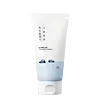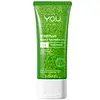What's inside
What's inside
 Key Ingredients
Key Ingredients

 Benefits
Benefits

 Concerns
Concerns

 Ingredients Side-by-side
Ingredients Side-by-side

Water
Skin ConditioningSodium Cocoyl Isethionate
CleansingGlycerin
HumectantSodium Methyl Cocoyl Taurate
CleansingCoco-Betaine
CleansingPotassium Cocoyl Glycinate
Potassium Benzoate
PreservativeSodium Chloride
MaskingPolyquaternium-67
Potassium Cocoate
EmulsifyingCitric Acid
BufferingFructooligosaccharides
HumectantSaccharide Hydrolysate
HumectantDisodium EDTA
Pullulan
1,2-Hexanediol
Skin ConditioningAllantoin
Skin ConditioningPanthenol
Skin ConditioningSea Water
HumectantSodium Acetate
BufferingButylene Glycol
HumectantChamomilla Recutita Flower Oil
MaskingCaprylic/Capric Triglyceride
MaskingBeta-Glucan
Skin ConditioningPhosphatidylcholine
EmulsifyingHyaluronic Acid
HumectantEthylhexylglycerin
Skin ConditioningCeramide NP
Skin ConditioningGlycine
BufferingHydrolyzed Hyaluronic Acid
HumectantGlutamic Acid
HumectantSerine
MaskingSodium Hyaluronate
HumectantLysine
Skin ConditioningAlanine
MaskingArginine
MaskingThreonine
Proline
Skin ConditioningWater, Sodium Cocoyl Isethionate, Glycerin, Sodium Methyl Cocoyl Taurate, Coco-Betaine, Potassium Cocoyl Glycinate, Potassium Benzoate, Sodium Chloride, Polyquaternium-67, Potassium Cocoate, Citric Acid, Fructooligosaccharides, Saccharide Hydrolysate, Disodium EDTA, Pullulan, 1,2-Hexanediol, Allantoin, Panthenol, Sea Water, Sodium Acetate, Butylene Glycol, Chamomilla Recutita Flower Oil, Caprylic/Capric Triglyceride, Beta-Glucan, Phosphatidylcholine, Hyaluronic Acid, Ethylhexylglycerin, Ceramide NP, Glycine, Hydrolyzed Hyaluronic Acid, Glutamic Acid, Serine, Sodium Hyaluronate, Lysine, Alanine, Arginine, Threonine, Proline
Water
Skin ConditioningSodium Laureth Sulfate
CleansingAcrylates Copolymer
Cocamidopropyl Betaine
CleansingDecyl Glucoside
CleansingButylene Glycol
HumectantGlycerin
HumectantPEG-150 Distearate
EmulsifyingSodium Chloride
MaskingPhenoxyethanol
PreservativePEG-7 Glyceryl Cocoate
EmulsifyingSodium Benzoate
MaskingSodium Hydroxide
BufferingPEG-40 Hydrogenated Castor Oil
EmulsifyingLactose
HumectantCellulose
AbsorbentMelaleuca Alternifolia Leaf Oil
AntioxidantPPG-26-Buteth-26
Skin ConditioningParfum
MaskingDisodium EDTA
Citric Acid
BufferingSodium Methyl Cocoyl Taurate
CleansingEthylhexyl Methoxycinnamate
UV AbsorberSalicylic Acid
MaskingButyl Methoxydibenzoylmethane
UV AbsorberEthylhexyl Salicylate
UV AbsorberHydroxypropyl Methylcellulose
Emulsion StabilisingJojoba Esters
EmollientCI 77288
Cosmetic ColorantQuaternium-73
CI 19140
Cosmetic ColorantAscorbyl Palmitate
AntioxidantTocopheryl Acetate
AntioxidantCI 42090
Cosmetic ColorantPanthenol
Skin ConditioningScutellaria Baicalensis Root Extract
AstringentPropanediol
SolventXylitylglucoside
HumectantAnhydroxylitol
HumectantXylitol
HumectantMadecassoside
AntioxidantHydrogenated Lecithin
EmulsifyingAsiaticoside
AntioxidantCeramide NP
Skin ConditioningRutin
AntioxidantHydroxycinnamic Acid
Skin ConditioningAsiatic Acid
Skin ConditioningMadecassic Acid
Skin ConditioningCaprylyl Glycol
EmollientCeramide Ns
Skin ConditioningCeramide As
Skin ConditioningGlyceryl Caprylate
EmollientStephania Tetrandra Root Extract
Skin ConditioningZinc PCA
HumectantCeramide EOP
Skin ConditioningCeramide AP
Skin ConditioningWater, Sodium Laureth Sulfate, Acrylates Copolymer, Cocamidopropyl Betaine, Decyl Glucoside, Butylene Glycol, Glycerin, PEG-150 Distearate, Sodium Chloride, Phenoxyethanol, PEG-7 Glyceryl Cocoate, Sodium Benzoate, Sodium Hydroxide, PEG-40 Hydrogenated Castor Oil, Lactose, Cellulose, Melaleuca Alternifolia Leaf Oil, PPG-26-Buteth-26, Parfum, Disodium EDTA, Citric Acid, Sodium Methyl Cocoyl Taurate, Ethylhexyl Methoxycinnamate, Salicylic Acid, Butyl Methoxydibenzoylmethane, Ethylhexyl Salicylate, Hydroxypropyl Methylcellulose, Jojoba Esters, CI 77288, Quaternium-73, CI 19140, Ascorbyl Palmitate, Tocopheryl Acetate, CI 42090, Panthenol, Scutellaria Baicalensis Root Extract, Propanediol, Xylitylglucoside, Anhydroxylitol, Xylitol, Madecassoside, Hydrogenated Lecithin, Asiaticoside, Ceramide NP, Rutin, Hydroxycinnamic Acid, Asiatic Acid, Madecassic Acid, Caprylyl Glycol, Ceramide Ns, Ceramide As, Glyceryl Caprylate, Stephania Tetrandra Root Extract, Zinc PCA, Ceramide EOP, Ceramide AP
 Reviews
Reviews

Ingredients Explained
These ingredients are found in both products.
Ingredients higher up in an ingredient list are typically present in a larger amount.
Butylene Glycol (or BG) is used within cosmetic products for a few different reasons:
Overall, Butylene Glycol is a safe and well-rounded ingredient that works well with other ingredients.
Though this ingredient works well with most skin types, some people with sensitive skin may experience a reaction such as allergic rashes, closed comedones, or itchiness.
Learn more about Butylene GlycolCeramide NP is a type of ceramide.
Ceramides are intercellular lipids naturally found in our skin that bonds dead skin cells together to create a barrier. They are known for their ability to hold water and thus are a great ingredient for dry skin.
Ceramides are an important building block for our skin barrier. A stronger barrier helps the skin look more firm and hydrated. By bolstering the skin ceramides act as a barrier against irritating ingredients. This can help with inflammation as well.
If you would like to eat ceramides, sweet potatoes contain a small amount.
Read more about other common types of ceramides here:
Ceramide AP
Ceramide EOP
Citric Acid is an alpha hydroxy acid (AHA) naturally found in citrus fruits like oranges, lemons, and limes.
Like other AHAs, citric acid can exfoliate skin by breaking down the bonds that hold dead skin cells together. This helps reveal smoother and brighter skin underneath.
However, this exfoliating effect only happens at high concentrations (20%) which can be hard to find in cosmetic products.
Due to this, citric acid is usually included in small amounts as a pH adjuster. This helps keep products slightly more acidic and compatible with skin's natural pH.
In skincare formulas, citric acid can:
While it can provide some skin benefits, research shows lactic acid and glycolic acid are generally more effective and less irritating exfoliants.
Most citric acid used in skincare today is made by fermenting sugars (usually from molasses). This synthetic version is identical to the natural citrus form but easier to stabilize and use in formulations.
Read more about some other popular AHA's here:
Learn more about Citric AcidDisodium EDTA plays a role in making products more stable by aiding other preservatives.
It is a chelating agent, meaning it neutralizes metal ions that may be found in a product.
Disodium EDTA is a salt of edetic acid and is found to be safe in cosmetic ingredients.
Learn more about Disodium EDTAGlycerin is already naturally found in your skin. It helps moisturize and protect your skin.
A study from 2016 found glycerin to be more effective as a humectant than AHAs and hyaluronic acid.
As a humectant, it helps the skin stay hydrated by pulling moisture to your skin. The low molecular weight of glycerin allows it to pull moisture into the deeper layers of your skin.
Hydrated skin improves your skin barrier; Your skin barrier helps protect against irritants and bacteria.
Glycerin has also been found to have antimicrobial and antiviral properties. Due to these properties, glycerin is often used in wound and burn treatments.
In cosmetics, glycerin is usually derived from plants such as soybean or palm. However, it can also be sourced from animals, such as tallow or animal fat.
This ingredient is organic, colorless, odorless, and non-toxic.
Glycerin is the name for this ingredient in American English. British English uses Glycerol/Glycerine.
Learn more about GlycerinPanthenol is a common ingredient that helps hydrate and soothe the skin. It is found naturally in our skin and hair.
There are two forms of panthenol: D and L.
D-panthenol is also known as dexpanthenol. Most cosmetics use dexpanthenol or a mixture of D and L-panthenol.
Panthenol is famous due to its ability to go deeper into the skin's layers. Using this ingredient has numerous pros (and no cons):
Like hyaluronic acid, panthenol is a humectant. Humectants are able to bind and hold large amounts of water to keep skin hydrated.
This ingredient works well for wound healing. It works by increasing tissue in the wound and helps close open wounds.
Once oxidized, panthenol converts to pantothenic acid. Panthothenic acid is found in all living cells.
This ingredient is also referred to as pro-vitamin B5.
Learn more about PanthenolChances are, you eat sodium chloride every day. Sodium Chloride is also known as table salt.
This ingredient has many purposes in skincare: thickener, emulsifier, and exfoliator.
You'll most likely find this ingredient in cleansers where it is used to create a gel-like texture. As an emulsifier, it also prevents ingredients from separating.
There is much debate on whether this ingredient is comedogenic. The short answer - comedogenic ratings don't tell the whole story. Learn more about comegodenic ratings here.
The concensus about this ingredient causing acne seems to be divided. Research is needed to understand if this ingredient does cause acne.
Scrubs may use salt as the primary exfoliating ingredient.
Learn more about Sodium ChlorideThis gentle cleansing and foaming ingredient is known for leaving a smooth feeling in skin and hair. It is made using coconut oil.
According to the manufacturer, it is soluble in water and has resistance to hard water, acid, and alkali.
Due to its coconut base, it may not be Malassezia folliculitis safe.
Learn more about Sodium Methyl Cocoyl TaurateWater. It's the most common cosmetic ingredient of all. You'll usually see it at the top of ingredient lists, meaning that it makes up the largest part of the product.
So why is it so popular? Water most often acts as a solvent - this means that it helps dissolve other ingredients into the formulation.
You'll also recognize water as that liquid we all need to stay alive. If you see this, drink a glass of water. Stay hydrated!
Learn more about Water